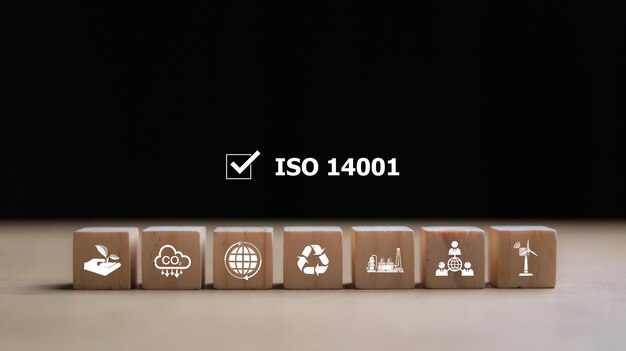I. Introduction
In today’s world, businesses are increasingly recognizing the importance of environmental sustainability. As organizations face mounting pressure to reduce their environmental footprint, ISO 14001 certification stands out as a globally recognized standard for environmental management. ISO 14001 provides a framework that helps organizations manage their environmental responsibilities efficiently, improve environmental performance, and enhance their reputation. This blog explores what ISO 14001 certification is, why it’s essential, the steps to achieve it, and how it benefits your organization in the long run.
II. What is ISO 14001 Certification?
ISO 14001 is an international standard that specifies the requirements for an effective Environmental Management System (EMS). It helps businesses manage their environmental impacts, ensuring that they operate in a more sustainable manner. The standard provides a structured approach for identifying environmental risks, setting objectives to reduce those impacts, and monitoring performance over time.
The key components of ISO 14001 include:
- Environmental Policy: A statement outlining the organization’s commitment to environmental protection.
- Planning: Identifying environmental impacts and setting objectives.
- Implementation and Operation: Creating processes to achieve environmental goals.
- Checking and Corrective Action: Monitoring progress and making adjustments.
- Management Review: Ensuring the EMS is continually improving.
By adopting ISO 14001, organizations can establish a comprehensive EMS that aligns with environmental best practices.
III. Why is ISO 14001 Certification Important?
ISO 14001 certification offers numerous advantages to organizations of all sizes, from manufacturing to service sectors. Here are some of the primary reasons it’s important:
- Improves Environmental Performance: By implementing ISO 14001, organizations can systematically reduce their environmental impact. This includes better waste management, energy efficiency, and reduced resource consumption.
- Cost Savings: An efficient EMS often leads to cost savings. For example, reducing energy consumption or minimizing waste can significantly cut operating expenses.
- Enhanced Reputation: ISO 14001 demonstrates to customers, stakeholders, and the public that your organization is committed to sustainable practices. This can lead to increased customer trust and brand loyalty.
- Regulatory Compliance: Many countries have strict environmental regulations. ISO 14001 helps businesses ensure compliance with these laws, reducing the risk of fines and legal issues.
- Competitive Advantage: With growing demand for sustainability, ISO 14001 certification can give companies a competitive edge in markets that prioritize environmental responsibility.
IV. The Key Steps to Achieve ISO 14001 Certification
Achieving ISO 14001 certification involves a step-by-step process that ensures your EMS is effective and compliant with the standard. Here’s a breakdown of the key steps:
Step 1: Commitment from Leadership
- ISO 14001 requires commitment from top management to ensure the environmental management system aligns with the organization’s strategy and goals.
Step 2: Conducting an Environmental Review
- Assess the organization’s current environmental impacts. Identify areas where improvements can be made in energy use, waste management, and other key environmental aspects.
Step 3: Setting Environmental Objectives and Targets
- Establish clear, measurable goals based on the results of the environmental review. These objectives should align with the company’s environmental policy and overall strategy.
Step 4: Developing an Environmental Management Plan
- Create action plans to meet environmental objectives. Assign responsibilities, allocate resources, and establish timelines.
Step 5: Implementing the EMS
- Put the management plan into action by developing and integrating environmental policies, procedures, and processes throughout the organization.
Step 6: Monitoring, Measurement, and Continuous Improvement
- Regularly monitor and measure the performance of the EMS. Use data to evaluate progress and make necessary adjustments to ensure continual improvement.
Step 7: Internal Audits and External Certification
- Conduct internal audits to verify that the EMS is functioning effectively. Once satisfied, undergo an external audit by an accredited certification body to achieve ISO 14001 certification.
V. Common Challenges in Achieving ISO 14001 Certification
While ISO 14001 certification brings immense benefits, the process of achieving it can come with challenges:
- Understanding Complex Regulations: Navigating through the environmental regulations specific to your industry or region can be daunting. Staying updated on laws and ensuring compliance requires time and effort.
- Employee Engagement and Training: For an EMS to be successful, all employees need to be on board. This means proper training and fostering a culture of environmental responsibility within the organization.
- Resource Allocation: Implementing an EMS may require initial investments in resources, technology, and manpower. This can be challenging for organizations with limited budgets.
- Resistance to Change: Employees and stakeholders may resist changes in processes or practices. Effective change management strategies are necessary to overcome this hurdle.
- Continuous Monitoring: Maintaining ISO 14001 certification requires ongoing monitoring, which can be resource-intensive. Staying on top of compliance and improving practices is essential to retain the certification.
VI. Benefits Beyond Certification: Why Maintain ISO 14001?
The benefits of ISO 14001 extend far beyond the certification itself. Here’s why maintaining ISO 14001 is essential for long-term success:
- Continuous Improvement: ISO 14001 promotes a culture of ongoing improvement. By regularly assessing your environmental performance, you can identify new opportunities for reduction, efficiency, and innovation.
- Long-term Sustainability: The standard helps ensure that your environmental management system remains effective and adaptable to changing regulations and business needs.
- Cost Reduction: Continued monitoring and improvement lead to ongoing savings in energy, waste management, and resource efficiency, which can have a positive impact on your bottom line.
- Increased Stakeholder Trust: Maintaining ISO 14001 reinforces your commitment to environmental responsibility, strengthening relationships with stakeholders, customers, and investors who prioritize sustainability.
- Global Recognition: ISO 14001 is recognized globally. As your organization expands internationally, the certification can facilitate market access and increase your credibility in new markets.
VII. Challenges in Achieving ISO 45001 Certification
While ISO 45001 offers numerous benefits, businesses may face challenges, including:
- High Implementation Costs: Initial investment in training, audits, and system upgrades.
- Time-Consuming Process: Achieving certification can take several months.
- Employee Resistance: Workers may resist new safety procedures and documentation requirements.
- Meeting Stringent Requirements: Organizations must document and prove compliance with safety standards.
Overcoming these challenges requires strategic planning, employee involvement, and management commitment.
VIII. How to Choose the Right ISO 45001 Certification Body
Selecting the right certification body is crucial for a smooth certification process. Consider the following factors:
- Accreditation: Ensure the body is accredited by a recognized organization like the International Accreditation Forum (IAF).
- Industry Experience: Choose a certifier with expertise in your industry.
- Reputation and Credibility: Research reviews and client feedback.
- Cost and Services: Compare pricing and support services offered.
IX. Conclusion
Achieving ISO 14001 certification is a strategic move for any organization that values sustainability and wants to minimize its environmental impact. The process of implementing an Environmental Management System based on this standard not only helps reduce risks and costs but also enhances your brand’s reputation and compliance with environmental regulations. Start today by committing to a sustainable future for your organization and make ISO 14001 a cornerstone of your environmental management strategy.








